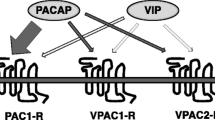Summary
Pituitary adenylate cyclase-activating polypeptide (PACAP) is a neuropeptide that occurs in several tissues, e.g., in the gut. We have studied PACAP-like immunoreactivity in the pancreas of rat and mouse, and the effects of PACAP-38 on basal and stimulated insulin and glucagon secretion in the mouse. Immunofluorescence staining demonstrated the presence of PACAP-like immunoreactivity in nerve fibers in both the rat and mouse pancreas. The nerve fibers were seen in the exocrine pancreas and surrounding the islets. Occasionally, the nerve fibers occurred within the islets. Most PACAP-positive nerve fibers innervated the intrapancreatic ganglia, although no nerve cell bodies contained PACAP-like immunoreactivity. In-vivo experiments in mice revealed that basal plasma glucagon levels were increased by PACAP-39 injected intravenously at dose levels exceeding 1.8 nmol/kg. Furthermore, PACAP-38 (7 nmol/kg) potentiated the plasma glucagon response to the cholinergic agonist carbachol (0.16 μmol/kg). This potentiation was reduced to simple addition by pretreatment with a combined α- and β-adrenergic blockade by phentolamine (35 μmol/kg) and propranolol (8.5 μmol/kg). Moreover, PACAP-38 inhibited a carbachol-induced increase in the level of plasma insulin in the absence but not in the presence of adrenergic blockade. PACAP-38 increased basal plasma insulin levels and increased basal plasma glucose levels 6 min and 10 min, respectively, after injection of the peptide. We conclude that PACAP-like immunoreactivity exists in nerve fibers innervating the mouse and rat pancreas, particularly the intrapancreatic ganglia, and that PACAP-38 augments both basal and carbachol-stimulated glucagon secretion in the mouse.
Similar content being viewed by others
References
Ahrén B (1991) Effects of helospectin I on insulin and glucagon secretion in the mouse. Br J Pharmacol 102:916–918
Ahrén B, Falck B (1991) Effects of helodermin and VIP on insulin and glucagon secretion in the mouse. Regul Pept 32:1–9
Ahrén B, Lundquist I (1981) Effects of selective and non-selective β-adrenergic agents on insulin secretion in mice. Eur J Pharmacol 71:93–104
Ahrén B, Lundquist I (1986) Secretin potentiates cholinergically induced glucagon secretion in the mouse. Acta Physiol Scand 128:574–578
Ahrén B, Lundquist I (1988) Effects of peptide HI on basal and stimulated insulin and glucagon secretion in the mouse. Neuropeptides 11:159–162
Ahrén B, Taborsky GJ Jr, Porte D Jr (1986) Neuropeptidergic versus cholinergic and adrenergic regulation of islet hormone secretion. Diabetologia 29:827–836
Ahrén B, Östenson C-G, Efendic S (1991) Other islet peptides. In: Samols E (ed) The endocrine pancreas. Raven, New York, pp 153–173
Bruss ML, Black AL (1978) Enzymatic microdetermination of glycogen. Anal Biochem 84:309–312
Coons AH, Leduc EM, Connolly JM (1955) Studies on antibody production. I. A method for the histochemical determination of specific antibodies and its application to a study of the hyperimmune rabbit. J Exp Med 102:49–59
Gottschall PE, Tatsuno I, Miyata A, Arimura A (1990) Characterization and distribution of binding sites for the hypothalamic peptide, pituitary adenylate cyclase activating polypeptide. Endocrinology 127:272–277
Herbert V, Lau KS, Gottlieb CW, Bleicher SJ (1965) Coated charcoal immunoassay of insulin. J Clin Endocrinol Metab 25:1875–1885
Järhult J, Holst JJ (1978) Reflex adrenergic control of endocrine pancreas evoked by unloading of carotid baroreceptors in cats. Acta Physiol Scand 104:188–202
Kawai K, Ohse C, Watanabe Y, Suzuki S, Yamashita K, Ohashi S (1992) Pituitary adenylate cyclase polypeptide stimulates insulin release from the isolated perfused rat pancreas. Life Sci 50:257–261
Köves K, Arkimura A, Somogyvvari-Vigh A, Vigh S, Miller J (1990) Immunohistochemical demonstration of a novel hypothalamic peptide, pituitary adenylate cyclase-activating polypeptide, in the ovine hypothalamus. Endocrinology 127:264–271
Miyata A, Arimura A, Dahl RR, Minamino N, Uehara A, Jiang L, Culler MD, Coy DH (1989) Isolation of a novel 38 residue-hypothalamic polypeptide which stimulates adenylate cyclase in pituitary cells. Biochem Biophys Res Commun 164:567–574
Miyata A, Jiang L, Dahl RD, Kitada C, Kubo K, Fujino L, Minamino N, Arimura A (1990) Isolation of a neuropeptide corresponding to the N-terminal 27 residues of the pituitary adenylate cyclase activating polypeptide with 38 residues (PACAP-38). Biochem Biophys Res Commun 170:643–648
Parker D, Raufman J-P, O'Donohue T, Bledsoe M, Yoshida H, Pisano J (1984) Amino acid sequences of helospectins, new members of the glucagon superfamily, found in Gila monster venom. J Biol Chem 259:11751–11755
Robberecht P, De Neef P, Vandermeers A, Vandermeers-Piret MC, Svoboda M, Meuris S, De Graef J, Woussencolle MC, Yanaihara C, Yanaihara N, Christophe J (1985) Presence of helodermin-like peptides of the VIP-secretin family in the mammalian salivary glands and saliva. FEBS Lett 190:142–146
Sundler F, Ekblad E, Absood A, Håkanson R, Köves K, Arimura A (1992) Pituitary adenylate-cyclase activating peptide: a novel vasoactive intestinal peptide-like neuropeptide in the gut. Neuroscience 46:439–454
Uddman R, Luts A, Arimura A, Sundler F (1991) Pituitary adenylate cyclase-activating peptide (PACAP), a new vasoactive intestinal peptide (VIP)-like peptide in the respiratory tract. Cell Tissue Res 265:197–201
Author information
Authors and Affiliations
Rights and permissions
About this article
Cite this article
Fridolf, T., Sundler, F. & Ahrén, B. Pituitary adenylate cyclase-activating polypeptide (PACAP): occurrence in rodent pancreas and effects on insulin and glucagon secretion in the mouse. Cell Tissue Res 269, 275–279 (1992). https://doi.org/10.1007/BF00319618
Received:
Accepted:
Issue Date:
DOI: https://doi.org/10.1007/BF00319618



